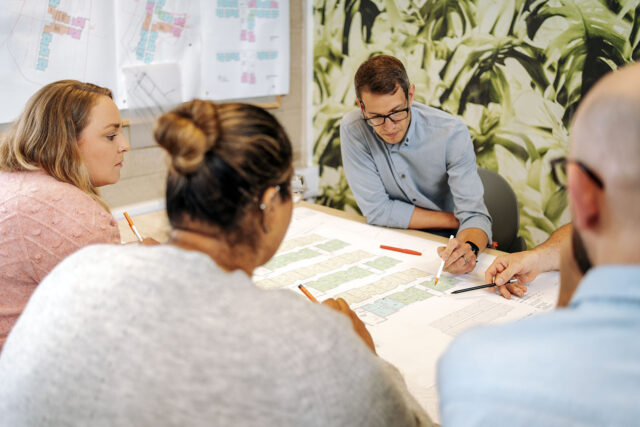In addition to our CDM2015 duties as Principal Designer, we can also offer the following services:
At Watson Batty we have always made health, safety and wellbeing a top priority, aligning our service with the requirements of the CDM Regulations. Our holistic and pragmatic approach cuts through bureaucracy whilst bringing safety to the heart of the project and protecting our clients’ best interests.
With the CDM2015 regulations placing enhanced responsibilities on all duty-holders but particularly on the Client, appointing Watson Batty as Principal Designer will offer you peace of mind in discharging your duties and delivering safe and healthy buildings, supported by robust documentation.
We have over 20 years of experience carrying out CDM duties, first as CDM Co-ordinators and then as Principal Designers. Our robust, ISO 9001, 14001 and 45001 accredited systems dovetail with our expertise in managing the design process and add real value without the unnecessary bureaucracy and paperwork.
All our lead designers are trained and experienced Principal Designers, so you benefit from our technical expertise and ability to suggest innovative solutions to reduce health and safety risks. Importantly, we understand the commercial and timescale pressures faced by the client alongside Health & Safety obligations and are here to help balance these project challenges to deliver your project safely, on time and on budget.
In addition, if appointed for both Architectural and Principal Designer services, we sit in a unique position at the centre of the project, leading the team ‘from the front’ through the collaborative process of design risk management. We can also offer discounted rates on the Principal Designer role for dual appointments, delivering even better value to the client.

Leading the team through effective design risk management and the application of the principles of prevention, ensuring all H&S risks are identified, eliminated, reduced, or managed
In addition to our CDM2015 duties as Principal Designer, we can also offer the following services:
On complex projects or where the Client requires additional support, we can also offer the added service of CDM advisor at strategic or site level. This can also include advice and support during RIDDOR investigations or in the case of health and safety disputes between the client and principal contractor.
We can help ensure that all consultants, principal contractor or contractors that are being engaged have sufficient skills, knowledge and experience to fulfil their duties under CDM, through a rigorous assessment of their personnel and organisational capabilities.
We can provide support to the Principal Designer or Designers where they may not have the in-house skills, capabilities or confidence to fulfil their role under CDM. It may also be where the lead consultant on the project is reluctant to take on the role of Principal Designer, or on Design & Build projects where the Principal Contractor has been asked by the Client to act as the Principal Designer. We can provide on-request examples of projects where we have successfully undertaken this support role.
We offer free CPD sessions providing an overview of the roles and responsibilities of the duty holders under CDM 2015. For more in-depth Principal Designer and CDM guidance we can also offer tailored training to meet the needs of your team.
If requested, we can also undertake site safety audits in the Construction Phase checking that the Principal Contractor has adequate safety measures and processes in place in line with their Construction Phase Health & Safety Plan and reporting to the Client with findings and action lists.
What are the CDM Regulations 2015?
The Construction Design and Management Regulations 2015, also known as CDM Regulations or CDM 2015, are regulations governing the way construction projects of all sizes and types are planned and managed.
CDM 2015 aims to ensure health and safety issues are appropriately considered during the development of construction projects. The overall goal is to reduce the risk of harm to those who have to build, use and maintain structures.
The key to the regulations is the COMMUNICATION, COLLABORATION AND COOPERATION between ALL parties involved to ensure Health and Safety is managed throughout the project and in-use.
Links:
The Construction (Design and Management) Regulations 2015 – Further information
Managing health and safety in construction – Guidance on Regulations L153 – Further information
What is ‘Construction Works’ under CDM 2015?
Definition of ‘Works’
However, in a published Q&A an HSE spokesman stated that:
“General maintenance of fixed plant which mainly involves mechanical adjustment, replacing parts or lubrication is unlikely to be construction work”
CDM 2015 makes an important distinction between projects with a single contractor (‘one-man band’ e.g. an electrician/decorator etc.) or multiple contractors (involving multiple trades and a Main Contractor).
What are the Client’s duties under CDM 2015?
For all projects, commercial clients must make suitable arrangements for managing their project including:
For domestic clients, the duties of the Client automatically pass on to the Contractor (single contractor project) or Principal Contractor (multiple contractors). The Client can also appoint the Architect as Principal Designer.
Links:
HSE – Commercial clients: roles and responsibilities – Further information
CITB – Industry guidance for Clients – Further information

For further information, a quote, or just an informal chat and advice, please contact catherine.blain@watsonbatty.com
In-house Health & Safety Manager
Lorem ipsum dolor sit amet, consectetur adipiscing elit. Mauris malesuada, mauris faucibus posuere lacinia, magna lorem consectetur nulla, quis sagittis justo nulla eu felis.